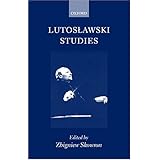
Average Reviews:

(More customer reviews)Are you looking to buy Lutoslawski Studies? Here is the right place to find the great deals. we can offer discounts of up to 90% on Lutoslawski Studies. Check out the link below:
>> Click Here to See Compare Prices and Get the Best Offers
Lutoslawski Studies ReviewLUTOSLAWSKI STUDIES, edited by Zbigniew Skowron, is one of the few in-depth English-language resources for learning about Lutoslawski's aesthetic and technique. As a mere fan of Lutoslawski and not a professional musicologist, I was happy to find several papers here that expanded my appreciation of the great Polish composer's work, although there are some too specialized for the layman.Perhaps the most thought-provoking paper here is "Change and Constancy" by Steven Stucky, which attempts to resolve how Lutoslawski's career can be broken up into legitimate segments. Stucky had previous written LUTOSLAWSKI AND HIS MUSIC (Oxford University Press, 1981), an overview of the composer's career which only went up to "Mi-Parti" of 1976. Right after that book appeared, however, Lutoslawski seemed to go off on a new path entirely, with the overtly tonal and more restrained works of his final years. In this paper, then, Stucky talks about what developments occurred in Lutoslawski's work, and what remained the same. Instead of seeing the 1960 development of limited aleatorism as the big break between early Lutoslawski and the mature composer, as is the traditional view, he claims that new harmonic developments instead are a key to the mature style from 1956 on. I disagree with Stucky's claim that the late works are just as good as the middle period--for me with their tonality and lack of complexity they become boring quickly--this is nonetheless an insightful paper.
"Considerations of Symphonic Form" by James Harley shows the development of Lutoslawski's take on the genre, including the use of the influential bipartite form (hestitant first movement, direct second movement) and symphonic features in the Cello Concerto and the Double Concerto. Maja Trochimczyk's "'Dans la Nuit': The Themes of Death and Night in Lutoslawski's Oeure" trace the continual reference to these two grim notions, including the existence of musical motifs representing them in the music. "On the Types of Chain Connections in the Late Music of Lutoslawski" by Irina Nikolska is a helpful guide to the theory behind several important works of the 1980s. Martina Homma's "Lutoslawski's Studies in Twelve-Tone Rows" is one of the most surprising papers here with its reference to a little-known "second path" of Lutoslawski's career, where he developed his theory alongside producing works; Homma refers to many sketches left at the Sacher foundation, and speaks of a violin concerto left unfinished at his death.
These are the papers which I found most interesting and accessible to the layman with little formal training in music. There are many quotations from the scores, and Oxford University Press' typesetting is eminently readable as always. If you are a dedicated fan of Lutoslawski, consider tracking this volume down.Lutoslawski Studies OverviewLutoslawski Studies presents for the first time an overview of the great twentieth-century composer Witold Lutoslawski's works and his compositional style, focusing on areas such as the composer's aesthetics, the evolution of his style, and the compositional strategies which apply to broader periods of his creativity.The international team of contributors bring to this study the results of recent research, offering a broader approach that links many issues which have been treated selectively in former studies, as well as throwing new light on the essence of the composer's music and the way in which modern and traditional elements co-exist.
Want to learn more information about Lutoslawski Studies?
>> Click Here to See All Customer Reviews & Ratings Now
0 comments:
Post a Comment